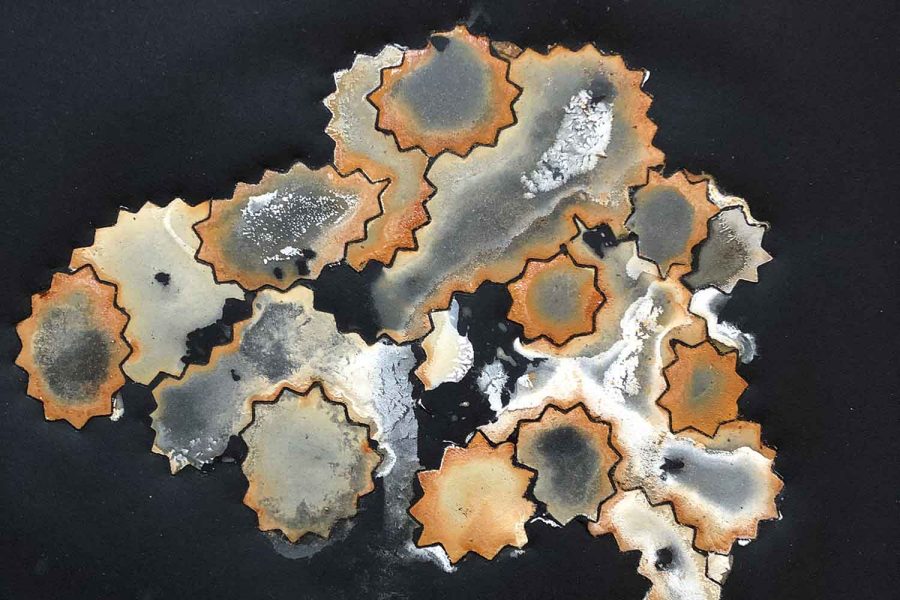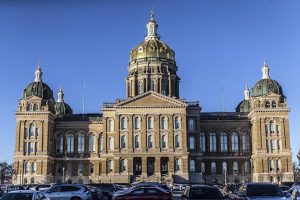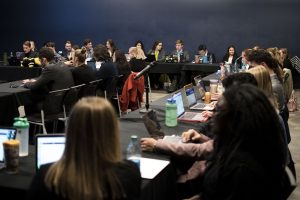UI printmaking professor creates artwork through influence of science
UI Printmaking professor Terry Conrad creates artwork showcasing single-celled organisms that live in the ocean after his experience with a research vessel.
January 23, 2019
UI printmaking Assistant Professor Terry Conrad has created artwork inspired by tagging along with a research mission studying tiny creatures called foraminifera, a group of single-cell organisms able to survive without oxygen.
Conrad joined a research cruise on the Research Vessel Robert Gordon Sproul off the coast of Santa Barbara in May 2018. Over a nine-day period, he assisted researchers from Woods Hole Oceanographic Institution in measuring and bottling samples taken from the ocean.
Conrad joined the crew to gain firsthand experience with the research project as well as assist in collecting sediment samples from the ocean, Joan Bernhard, a senior Woods Hole Oceanographic Institute scientist, said .
The research project was focused on studying the genetic response of foraminifera to lower oxygen levels in different parts of the ocean, Bernhard said. The organism’s response to lower levels of oxygen is important because the oxygen levels in the ocean will continue to decrease because of global warming, she said.
After his experience with the research group, Conrad began to construct the printing press he would use to create prints depicting the foraminifera. The prints, along with works by other artists, are part of an exhibit on display at the Courthouse Gallery in Lake George, New York, from Jan. 19 to Feb. 22.
Bernhard’s interest in a science and art collaboration stems from being visually oriented, she said. Having a partnership between the two allows for better communication and understanding among people who think visually versus analytically, she said.
RELATED: Local printmakers create resistance images in open house
“… I felt that the visual arts were a useful means to convey to the public the significance of this scientific research,” Bernhard said. “In particular, the group of organisms that I focus on, the foraminifera, have fantastically beautifully shaped ‘hard parts’ called tests (like a shell). I thought artists might find them visually interesting and thus a means to bridge science and art.”
The printing press itself is made up of broken tools the researchers gave him and is modeled to look similar to the tools used on the boat, Conrad said. In order to understand the researchers’ equipment, he related them to the tools used in printmaking, he said.
“[The printing press and prints] are more about slowing things down when everything is so fast in our days,” Conrad said. “It’s a slow process; the print takes a couple days and looks slightly different every time.”
When it came time to name the prints, Conrad said he asked Bernhard and Sam Bowser, a cell biologist specializing in the study of foraminifera, for help. Because he’s still working on the prints, each of them is numbered, he said.
Conrad was offered the opportunity to be a part of the research through his connection with Bowser after meeting at an art gallery in 2014. Bernhard was Bowser’s postdoctoral associate, and the two became close colleagues after that, Bowser said.
The colors and patterns of Conrad’s printmaking make one think of the ocean floor, and the prints depicted the organisms well, Bowser said.
“This is a really important point: Scientists aren’t very good communicators,” Bowser said. “We’re not trained to communicate our ideas. Artists can help scientists communicate with the general public about their work.”
Foraminifera are “the most important organisms you never heard of,” Bowser said. The organisms live in low-oxygen areas that are naturally occurring. As the number of low-oxygen areas continues to increase, understanding the naturally occurring areas will help predict what will happen in the future, he said.
Currently, Conrad is working on creating more prints for solo exhibits. One of the exhibits is in St. Louis in April and the other is at the Woods Hole Oceanographic Institution in Woods Hole, Massachusetts, in August. He is in the process of working on 25 prints, working toward the August gallery date, Conrad said.
“My work is interested in process and just things in general,” Conrad said. “It’s just really fun that I built this tool, and I’ll show it multiple times, and each time it’ll look different.”






